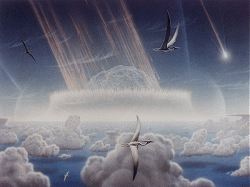hazards to extraterrestrial civilizations

The giant elliptical, M87
Whatever species exist on other worlds, they must inevitably, as terrestrial life-forms do, face a variety of threats to their existence. These threats may come in the form of competition or predation from other species, gradual adverse changes in the environment (for example, due to the onset of an ice age), or a sudden cataclysm, such as the impact of an asteroid or comet, a massive stellar flare, or the eruption of a nearby gamma-ray burster, capable of causing a mass extinction or even a complete planetary sterilization (see cosmic catastrophes, biological effects).
In addition to these natural dangers, many more of a self-inflicted nature may confront an intelligent race (and its fellow species) once it has achieved a substantial level of technology. Among these are the very hazards which humanity presently faces:
· Large-scale nuclear or biological war
· Global epidemics of lethal disease resulting from
· the emergence of antibiotic-resistant pathogens
· back-contamination
· Environmental disasters stemming from a combination of industrial
pollution, over-population, and destruction of natural habit, including
· global warming due to a gradual elevation in the level of gases that gives rise to the greenhouse
gases
· disintegration of the ozone layer
· Unforeseen side-effects of new technologies, such as genetic
engineering
As Shklovskii and Sagan have pointed out:1
We can imagine two extreme alternatives ... : (a) a technical civilization destroys itself soon after reaching the [interstellar] communicative phase (... less than 10² years); or (b) a technical civilization learns to live with itself soon after the communicative phase. If it survives more than 10² years, it will be unlikely to destroy itself afterwards. In the latter case, its lifetime may be measured on a stellar evolutionary timescale (... much greater than 108 years).
Since we cannot even predict the near-term fate of our own species, we are in no position to say whether advanced civilizations tend to survive for long periods or whether they self-destruct soon after acquiring the means to communicate over interstellar distances. Furthermore, even if technological races, on the whole, manage to overcome the problems they create, it is not clear how often natural disasters tend to purge a world of its life and intelligence. There are some indications, for example, that the Sun is an unusually placid star and also that, in the past gamma-ray bursters were much more common and may have periodically sterilized galaxies of their life before intelligent beings developed the means for interstellar communication and travel.
Reference
1. Shklovskii, I. S., and Sagan, Carl. Intelligent Life in the Universe. New York: Dell (1966).


